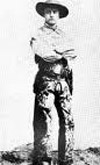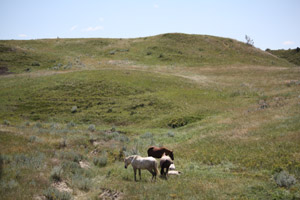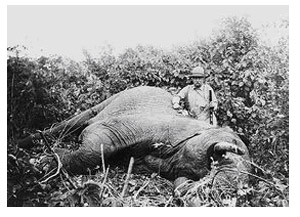By the Never-Bored RVers
In Part 1, you read about Theodore Roosevelt’s influence in preserving some of America’s most beautiful, unique lands so that we can say, “WOW” over and over again as we travel this great nation. We can appreciate that while so many things change around us, the Grand Canyon and Crater Lake National Parks, Devils Tower National Monument and other wonders of nature will be here for our grandchildren and their grandchildren to enjoy.
But there’s lots more fascinating information worth knowing about Teddy; for instance, upon the assassination of President William McKinley in 1901, Roosevelt, at age 42, became the youngest President in U.S. history.
In his political life, Roosevelt attempted to move the Republican Party in the direction of Progressivism, including trust-busting and increased regulation of businesses. He coined the phrase “Square Deal” to describe his domestic agenda to emphasize that the average citizen would get a fair shake under his policies.
[A personal comment: In politics and government, decision-makers will always have their supporters and opponents. Many of Roosevelt’s programs and opinions weren’t popular or, by today’s standards, wouldn’t be considered politically correct. But at the turn of the 20th Century there were excesses that threatened what he considered the American way of life, and he stood firm in his efforts to fix the problems.]
On the world stage, Roosevelt’s policies were characterized by his slogan, “Speak softly and carry a big stick.”
As a frail child born to a wealthy family, Roosevelt suffered from asthma, but his physical weakness didn’t stop him from leading a strenuous life. He was home-schooled and became a passionate student of nature. His first historical book, “The Naval War of 1812” published in 1882, established his reputation as a serious historian.
 In his 20s, he fitted himself out in an expensive cowboy get-up and left New York for the Badlands of South Dakota, where he bought a ranch and raised cattle, quickly overcoming the “dude from the East” reputation. Roosevelt built a second ranch, which he named Elk Horn near the boomtown of Medora, North Dakota (which is the South Entrance to one of the three sections of what is now Theodore Roosevelt National Park). On the banks of the Little Missouri, Roosevelt learned to ride western style, rope, and hunt. He rebuilt his life and began writing about frontier life for Eastern magazines.
In his 20s, he fitted himself out in an expensive cowboy get-up and left New York for the Badlands of South Dakota, where he bought a ranch and raised cattle, quickly overcoming the “dude from the East” reputation. Roosevelt built a second ranch, which he named Elk Horn near the boomtown of Medora, North Dakota (which is the South Entrance to one of the three sections of what is now Theodore Roosevelt National Park). On the banks of the Little Missouri, Roosevelt learned to ride western style, rope, and hunt. He rebuilt his life and began writing about frontier life for Eastern magazines.

Watching the Wild (Feral) Horses in Theodore Roosevelt National Park was a Highlight of our Last Visit to North Dakota
An unusually severe winter in 1886-1887 wiped out his herd of cattle and his $60,000 investment, so he returned to the East, where in 1885 he had built Sagamore Hill in Oyster Bay, New York.
The saga of an incredible life continues: While he and his bride, Edith Kermit Carow, honeymooned in Europe, Roosevelt led a party to the summit of Mont Blanc, a feat which resulted in his induction into the British Royal Society.
At age 37, Roosevelt became president of the board of New York City Police Commissioners. The city’s police force was reputed to be one of the most corrupt in America, but as “an iron-willed leader of unimpeachable honesty, (who) brought a reforming zeal to the New York City Police Commission in 1895,” Roosevelt and his fellow commissioners established new disciplinary rules, created a bicycle squad to police New York’s traffic problems, and standardized the use of pistols by officers.
Roosevelt made a habit of walking officers’ beats late at night and early in the morning to make sure they were on duty. He went on to become governor of New York State before becoming vice president of the U.S., from which he succeeded McKinley as president.
As governor of New York, he boxed with sparring partners several times a week, a practice he regularly continued as president until one blow detached his left retina, leaving him blind in that eye. Thereafter, he practiced judo attaining a third-degree brown belt and continued his habit of skinny-dipping in the Potomac River during winter.
As president, Roosevelt continued McKinley’s policies. One of his first notable acts as president was to deliver a 20,000-word address to Congress asking it to curb the power of large corporations (called “trusts”). For his aggressive attacks on trusts over his two terms he has been called a “trust-buster.” In the 1904 presidential election, Roosevelt won the presidency in his own right in a landslide victory, but declined to run for re-election in 1908.
Roosevelt was able to get what today are considered to be laws to benefit consumers, such as The Meat Inspection Act of 1906 and The Pure Food and Drug Act. The Meat Inspection Act banned misleading labels and preservatives that contained harmful chemicals. The Pure Food and Drug Act banned food and drugs that are impure or falsely labeled.
In 1905, he issued a corollary to the Monroe Doctrine, which allows the United States to “exercise international policy power” to intervene and keep smaller countries on their feet.
While campaigning in Wisconsin, Roosevelt gave a 90-minute speech shortly after being shot and bleeding from a bullet wound in his chest by a saloonkeeper.
After leaving office as president, he embarked on a safari to Africa. In March 1909, financed by Andrew Carnegie and by his own proposed writings, Roosevelt’s party hunted for specimens for the Smithsonian Institution and for the American Museum of Natural History in New York.  All told, Roosevelt and his companions killed or trapped more than 11,397 animals, from insects and moles to hippopotamuses and elephants. These included 512 big game animals, including six rare white rhinos. The expedition consumed 262 of the animals. Tons of salted animals and their skins were shipped to Washington; the quantity was so large that it took years to mount them all, and the Smithsonian was able to share many duplicate animals with other museums.
All told, Roosevelt and his companions killed or trapped more than 11,397 animals, from insects and moles to hippopotamuses and elephants. These included 512 big game animals, including six rare white rhinos. The expedition consumed 262 of the animals. Tons of salted animals and their skins were shipped to Washington; the quantity was so large that it took years to mount them all, and the Smithsonian was able to share many duplicate animals with other museums.
He was then off on a tour of Europe followed by a major expedition to South America, where he and his party traveled the Rio de Duvida, the River of Doubt, a river whose name was changed to Rio Roosevelt. It was during that trip that Roosevelt contracted malaria and a serious infection from a leg wound. In his delirium, he realized that his illness would endanger his fellow explorers who were short on supplies, and he begged to be left behind – but his son talked him out of staying there to die.
He was weakened but returned to America to live out his life with on-going bouts from the malaria. Roosevelt’s popular book “Through the Brazilian Wilderness” describes his expedition into the Brazilian jungle in 1913. The book describes the scientific discovery, scenic tropical vistas and exotic flora and fauna experienced during the adventure.
There are many, many more elements of his life that make good reading, including his founding of “The Bull Moose Party” and his powerful role in the politics of America and the world. He was influential in the Boy Scouts and the National Geographic Society.
Roosevelt was also an avid reader, reading tens of thousands of books at a rate of several a day in multiple languages.
My 11-year-old granddaughter asked me what I was writing, and when I told her, of course she mentioned the role played by Robin Williams in “Night at the Museum,” but she also informed me that there is a 2-DVD set from the History Channel about his life that she and her dad enjoyed.
In closing this series, I ask you to think about this: Where else – other than in America – could one person have shaped so many elements in our culture. Next time you’re in a National Park and see the name Theodore Roosevelt, realize that he earned his place on incredible Mt. Rushmore
From the “Never-Bored RVers,” We’ll see you on down the road.
Pingback: Homepage
W6PEA
I have looking at your article’s about Teddy Roosevelt, for the past week. I thought well maybe I should read it. I’m sure glad that I did. Great article, well written. I was unaware that the President didn’t have the power to declare an area a National Park, and that only Congress had that power. I was also unaware that President Roosevelt held the Congressional Medal of Honor. Maybe I should open a history book.
Thank you very much for the great article.
Doug
Enjoyed you blog on Roosevelt. I have a question about your Alaska trip. Did you have satellite tv in Canada & Alaska or cable in rv campgrounds. Really enjoyed reading about your trip to Alaska.
Judy Brown
My Grandfather was in the Rough Riders with Teddy Roosevelt and told stories to me about his experiences of joining while working at a ranch in Arizona. When he returned to the States he wrote several articles for our hometown newspapers in Illinois (his birth place). Our family has always been a fan of Roosevelt, a great man, and not enough said about him in our history books.
Ross an April
My wife and I really enjoy you sharing your information. We look forward to your stories
Ross an April
My wife and I really enjoy your articles. We really look forward to them.
LARRY DAMBA
EXCELLENT BLOG, I DIDN’T LEAARN SO MUCH ABOUT THIS INCREDABLE MAN IN ANY OF MY SCHOOLING. YOU HAVE MADE IT VERY INTERESTING AND I HOPE YOU CONTINUE TO WRITE ON MORE TOPICS
Jim Stevens
Blaa blaa blaa only in america blaa blaa
john
I would like to make one minor correction to the article. T. Roosevelt’s first ranch was the Maltese Cross Ranch also known as the Chimney Butte Ranch was located about seven miles south of Medora, North Dakota in the Badlands of North Dakota, not South Dakota.
Here is a link with more information: http://www.nps.gov/thro/historyculture/maltese-cross-cabin.htm
butterbean carpenter
Howdy Monique & Barry,
Thank you, once again for a great write-up on one of my heroes!!
Dave
The republican party sure has changed since Teddy’s time.
Ron Clement
Oh to have Teddy as our leader in these troubled times!
Dave
The republican party sure as changed since Teddy’s time.
Gary Case
Who woulda thought that you can gain even more information just by reading a blog? This is a wonderful insight into a very interesting man, who’s accomplishments far exceeded his capacity to do so. Thank you for the “report”
Jerry X Shea
Great 2 part article. Way to go guys. Just saw Crater Lake this past August. Have enjoyed all of Roosevelt’s parks.
Judy
Wonderful commentary. That you for the history lesson.